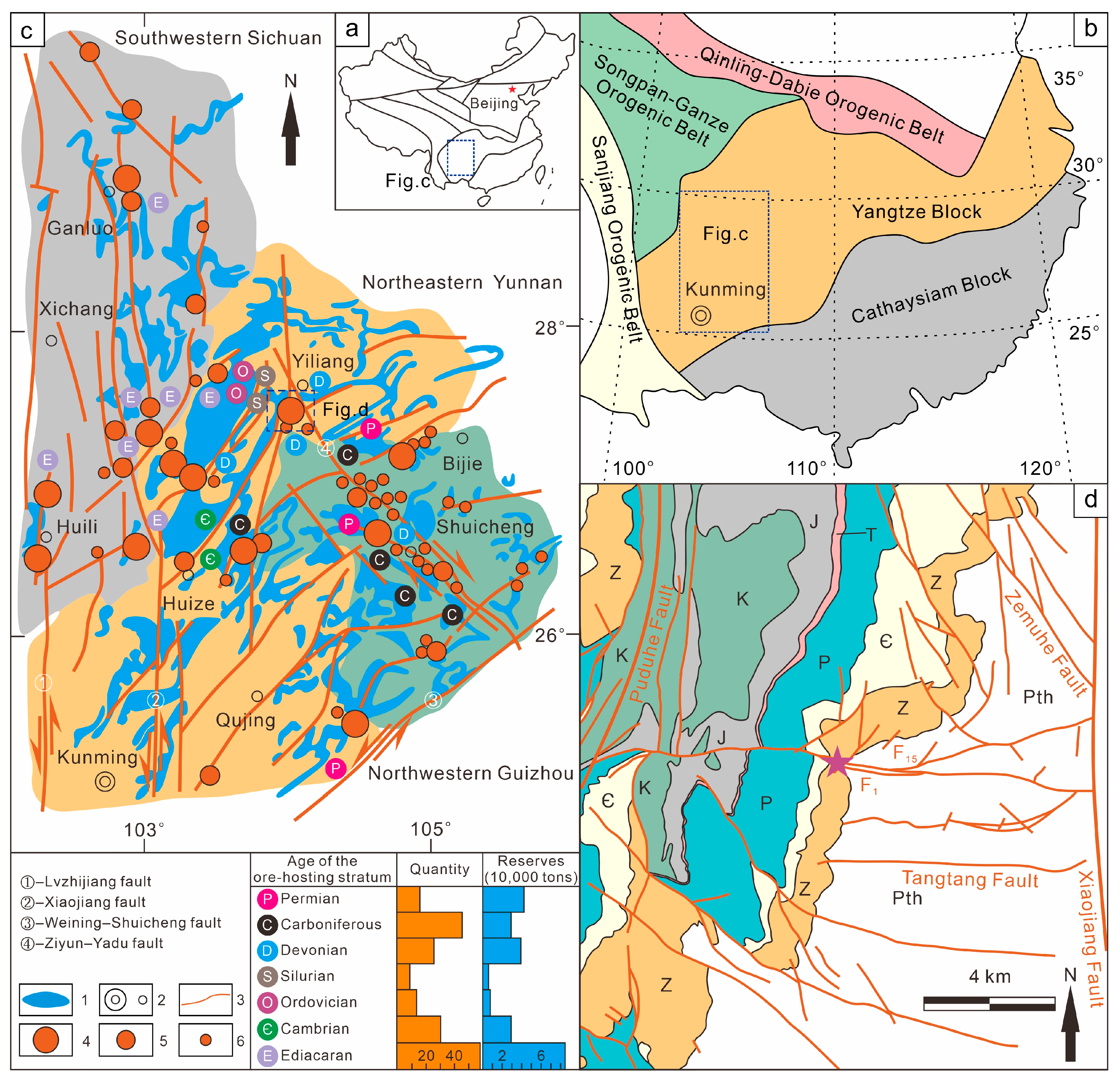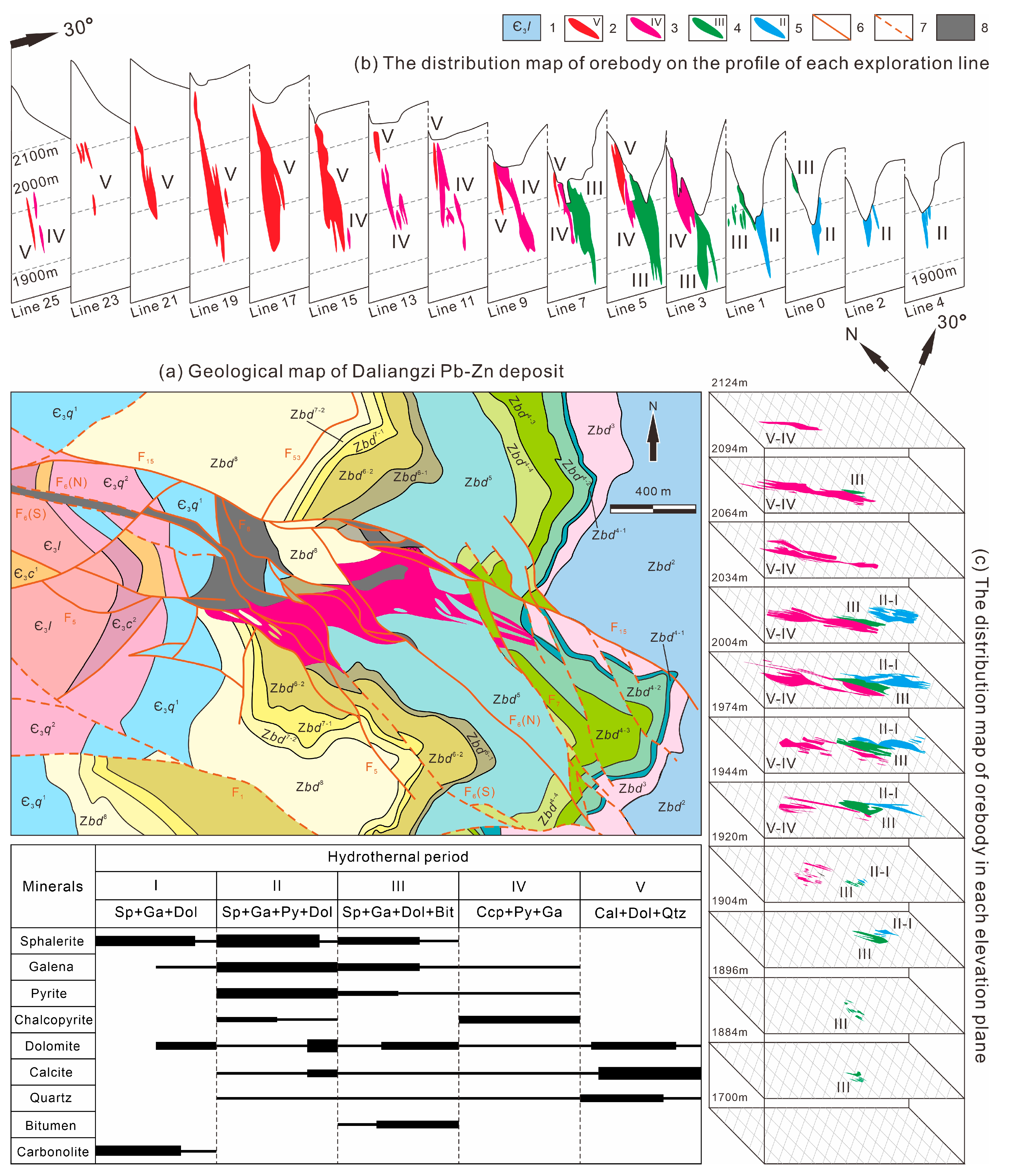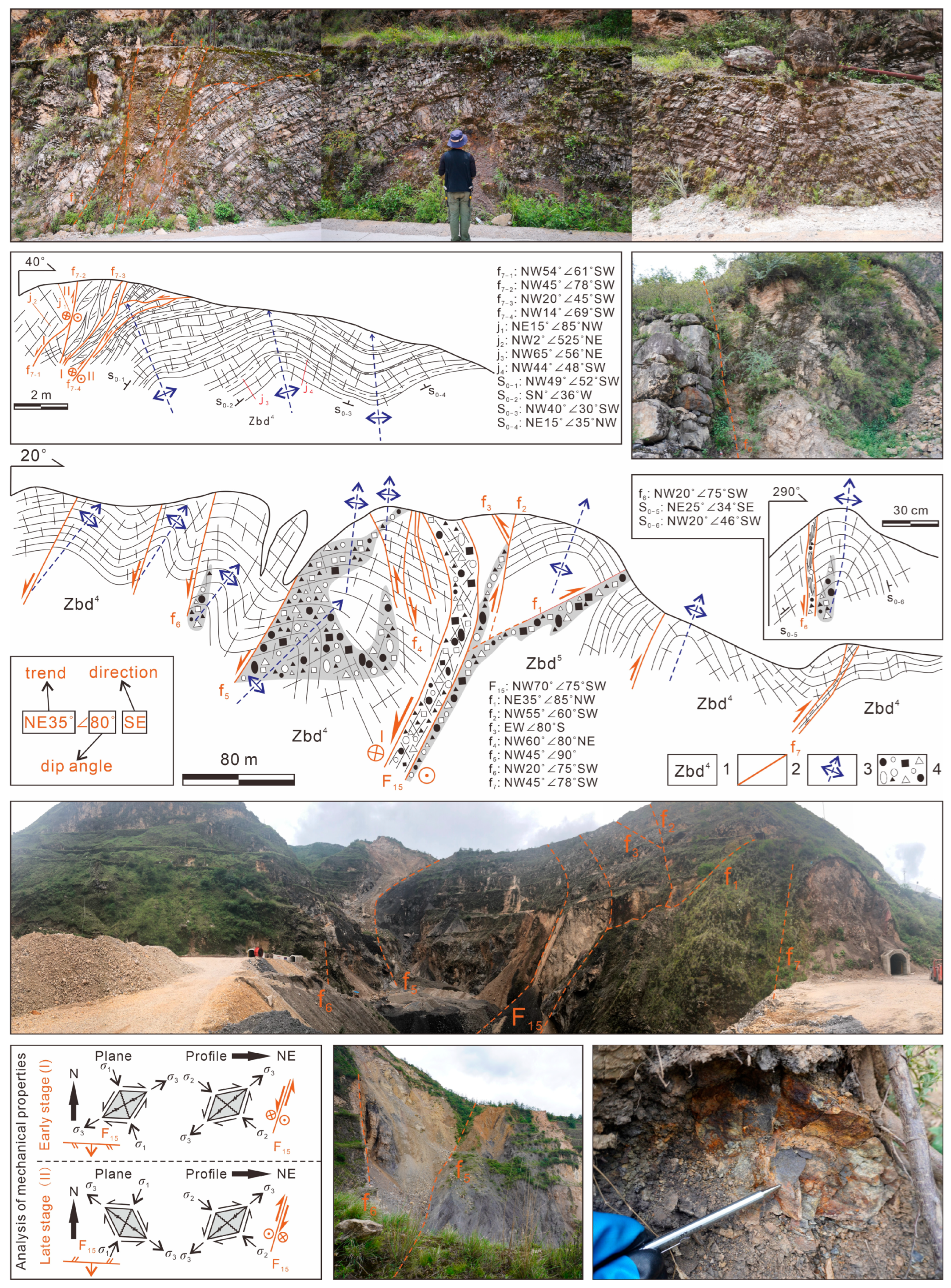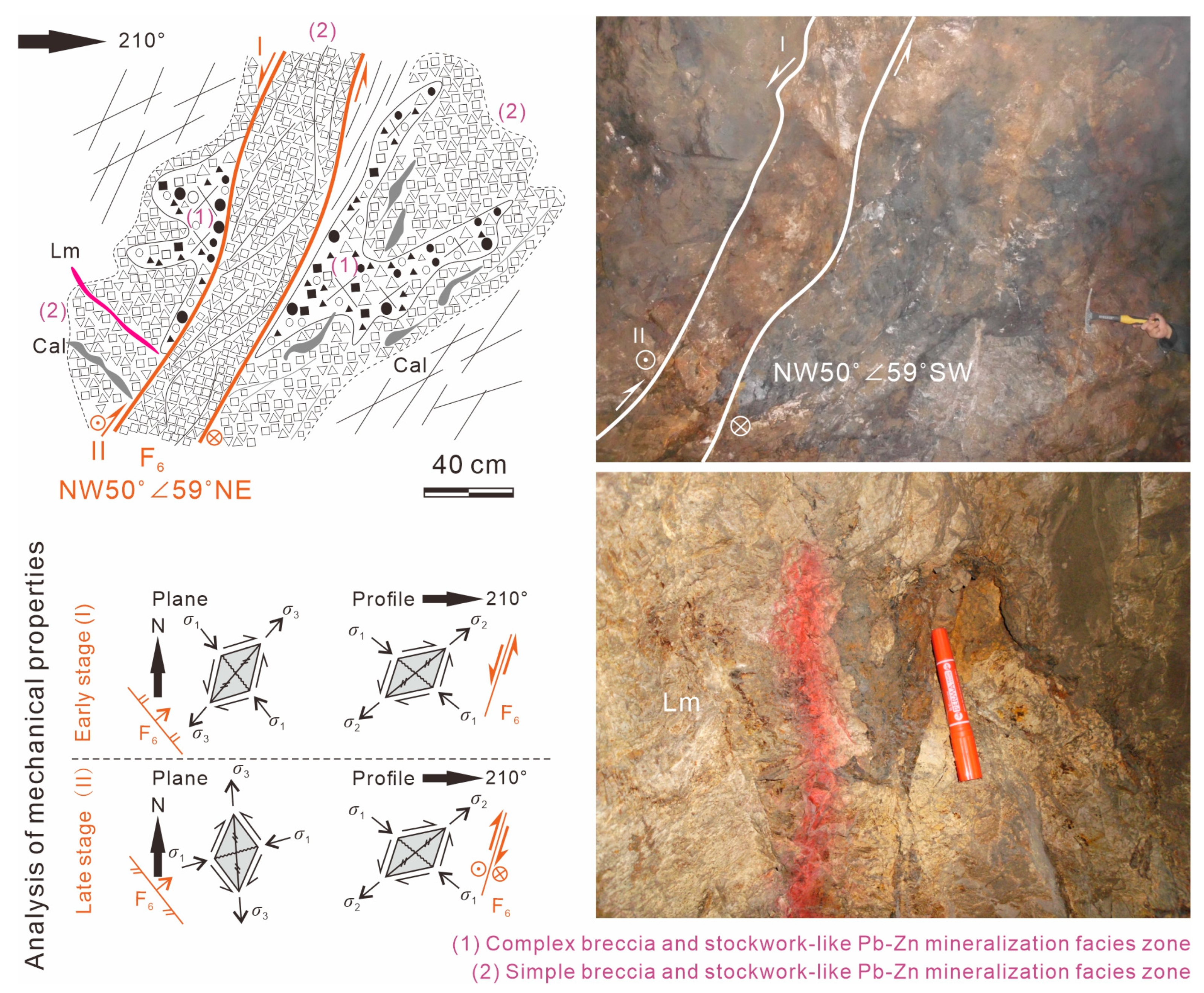Structural Ore-Control Model of the Daliangzi Pb–Zn Deposit, Southwest China
Abstract
1. Introduction
2. Geological Setting
3. Materials and Methods
4. Results
4.1. Structural Hierarchal Ore-Controlling Pattern
4.2. Fine Analysis of Ore-Controlling Structures
- (1)
- Fourth-order (deposit and ore section)
- (2)
- Fifth-order (orebody)
- (3)
- Sixth-order (ore block/vein)
4.3. Characteristics of the Black Alteration/Brecciation Zone
5. Discussion
5.1. Ore-Controlling Mechanism of Fault-Fold Structure
5.2. Oblique Distribution Patterns and the Underlying Mechanical Model at Different Scales
5.3. Structural Ore-Controlling Model
5.4. Prospecting Prediction
6. Conclusions
Author Contributions
Funding
Data Availability Statement
Conflicts of Interest
References
- Sibson, R.H. Controls on maximum fluid overpressure defining conditions for mesozonal mineralisation. J. Struct. Geol. 2004, 26, 1127–1136. [Google Scholar] [CrossRef]
- Han, R.S.; Wu, J.B.; Zhang, Y.; Chen, Q.; Sun, B.T. Oblique distribution patterns and the underlying mechanical model of orebody groups controlled by structures at different scales. Sci. Rep. 2024, 14, 4591. [Google Scholar] [CrossRef]
- Dolan, J.F.; McAuliffe, L.J.; Rhodes, E.J.; McGill, S.F.; Zinke, R. Extreme multi–millennial slip rate variations on the Garlock fault, California: Strain super–cycles, potentially time–variable fault strength, and implications for system–level earthquake occurrence. Earth Planet. Sci. Lett. 2016, 446, 123–136. [Google Scholar] [CrossRef]
- Mildon, Z.K.; Roberts, G.P.; Faure Walker, J.P.; Toda, S. Coulomb pre–stress and fault bends are ignored yet vital factors for earthquake triggering and hazard. Nat. Commun. 2019, 10, 2744. [Google Scholar] [CrossRef]
- Mildon, Z.K.; Roberts, G.P.; Faure Walker, J.P.; Toda, S. Surface faulting earthquake clustering controlled by fault and shear–zone interactions. Nat. Commun. 2022, 13, 7126. [Google Scholar] [CrossRef]
- Wicks, C.; de La Llera, J.C.; Lara, L.E.; Lowenstern, J. The role of dyking and fault control in the rapid onset of eruption at Chaitén volcano, Chile. Nature 2011, 478, 374–377. [Google Scholar] [CrossRef]
- Arnulf, A.F.; Biemiller, J.; Lavier, L.; Wallace, L.M.; Bassett, D.; Henrys, S.; Pecher, I.; Crutchley, G.; Plaza Faverola, A. Physical conditions and frictional properties in the source region of a slow–slip event. Nat. Geosci. 2021, 14, 334–340. [Google Scholar] [CrossRef]
- Cox, S.F.; Ruming, K. The St Ives mesothermal gold system, Western Australia—A case of golden aftershocks? J. Struct. Geol. 2005, 26, 1109–1125. [Google Scholar] [CrossRef]
- Ghosh, P.; Bhattacharyya, K. Investigating inter-relationships among kinematic vorticity, strain, and minimum translations from shear zones associated with internal thrusts of major fold-thrust belts. Earth-Sci. Rev. 2022, 231, 104093. [Google Scholar] [CrossRef]
- Li, H.; Zhou, J.; Ouyang, L.; Algeo, T.J.; Sun, W.; Xie, Y.; Li, X.; Wang, Z. Multi-stage magmatism and Sn-polymetallic mineralization in the Shuicheng Region, SW China. Lithos 2024, 478–479, 107624. [Google Scholar] [CrossRef]
- Li, H.; Wang, C.; Zhu, D.P.; Jiang, W.C. Metallogenic environment of skarn-type and vein-type Pb-Zn ore body in the Huangshaping deposit and its implications of deep deposit exploration. Chin. J. Nonferr. Met. 2023, 33, 630–651. [Google Scholar]
- Gao, R.Z.; Xue, C.J.; Dai, J.F.; Man, R.H.; Hou, M.J.; Xiao, Y. Geological, geochemical and geochronological characteristics of the Jiashi sandstone-hosted Cu deposit in the Kalpin fold-thrust belt in front of South Tianshan Orogen and their implications. Ore Geol. Rev. 2025, 185, 106822. [Google Scholar] [CrossRef]
- Smeraglia, L.; Aldega, L.; Bernasconi, S.M.; Billi, A.; Bigi, S.; di Marcantonio, E.; Fiorini, A.; Kylander-Clark, A.; Carminati, E. Structural and stratigraphic control on fluid flow in the Mt. Conero anticline, Italy: An analog for offshore resource reservoirs in fold-and-thrust belts. J. Struct. Geol. 2025, 200, 105502. [Google Scholar] [CrossRef]
- Wu, J.B.; Han, R.S.; Feng, Z.X.; Wu, P.; Gong, H.S.; Ding, T.Z.; Zhao, X.Y.; Li, L.J.; Yang, B.; Yuan, H. F15 master-control fault and its ore-controlling effect of the Daliangzi lead-zinc deposit of southwestern Sichuan. Geol. Bull. China 2022, 41, 1869–1886. [Google Scholar]
- Sun, J.C.; Han, R.S. Theory and Method of Minefield Geomechanics; Science Press: Beijing, China, 2016; pp. 1–356. [Google Scholar]
- Yan, D.P.; Zhou, M.F.; Song, H.L.; Wang, X.W.; Malpas, J. Origin and tectonic significance of a Mesozoic multi-layer over-thrust system within the Yangtze Block (South China). Tectonophysics 2003, 361, 239–254. [Google Scholar] [CrossRef]
- Qiu, L.; Yan, D.P.; Tang, S.L.; Wang, Q.; Yang, W.X.; Tang, X.; Wang, J. Mesozoic geology of southwestern China: Indosinian foreland overthrusting and subsequent deformation. J. Asian Earth Sci. 2016, 122, 91–105. [Google Scholar] [CrossRef]
- Hu, R.Z.; Fu, S.L.; Huang, Y.; Zhou, M.F.; Fu, S.H.; Zhao, C.H.; Wang, Y.J.; Bi, X.W.; Xiao, J.F. The giant South China Mesozoic low-temperature metallogenic domain: Reviews and a new geodynamic model. J. Asian Earth Sci. 2017, 137, 9–34. [Google Scholar] [CrossRef]
- Liu, H.C.; Lin, W.D. Research on the Regularity of Lead-Zinc-Silver Deposits in Northeast Yunnan; Yunnan University Press: Kunming, China, 1999; pp. 1–468. [Google Scholar]
- Li, L.J.; Han, R.S.; Wu, J.B.; Feng, Z.X. The zoning rule and forming mechanism of tectonite-mineralized alteration lithofacies of black/fracture zone of the Daliangzi Pb–Zn deposit in southwest Sichuan in China. Acta Geochim. 2025, 1–20. [Google Scholar] [CrossRef]
- Wu, Y. The Age and Ore-Forming Process of MVT Deposits in the Boundary Area of Sichuan-Yunnan-Guizhou Provinces, Southwest China. Ph.D. Thesis, China University of Geosciences, Beijing, China, 2013. [Google Scholar]
- Curewitz, D.; Karson, J.A. Structural settings of hydrothermal outflow: Fracture permeability maintained by fault propagation and interaction. J. Volcanol. Geotherm. Res. 1997, 79, 149–168. [Google Scholar] [CrossRef]
- Sillitoe, R.H. Gold-rich porphyry deposits: Descriptive and genetic models and their role in exploration and discovery. SILLITOE R. H. SEG Rev. 2000, 13, 315–345. [Google Scholar]
- Goldfarb, R.J.; Groves, D.I.; Gardoll, S. Orogenic gold and geologic time: A global synthesis. Ore Geol. Rev. 2001, 18, 1–75. [Google Scholar] [CrossRef]
- Betts, P.G.; Lister, G.S. Geodynamically indicated targeting strategy for shale-hosted massive sulfide Pb–Zn–Ag mineralisation in the Western Fold Belt, Mt Isa terrane. Aust. J. Earth Sci. 2002, 49, 985–1010. [Google Scholar] [CrossRef]
- Bierlein, F.P.; Murphy, F.C.; Weinberg, R.F.; Lees, T. Distribution of orogenic gold deposits in relation to fault zones and gravity gradients: Targeting tools applied to the Eastern Goldfields, Yilgarn Craton, Western Australia. Miner. Depos. 2006, 41, 107–126. [Google Scholar] [CrossRef]
- Dressel, B.C.; Chauvet, A.; Trzaskos, B.; Biondi, J.C.; Bruguier, O.; Monié, P.; Villanova, S.N.; Newton, J.B. The Passa Três lode gold deposit (Paraná State, Brazil): An example of structurally-controlled mineralisation formed during magmatic-hydrothermal transition and hosted within granite. Ore Geol. Rev. 2018, 102, 701–727. [Google Scholar] [CrossRef]
- Li, H.; Li, Y.; Yang, G.; Philemon, L.; Wan, Y.; Zhao, Q.; Wang, P. Prospecting for ophiolite-type chromite deposit in Sartohay, West Junggar (NW China): Constraints from geological and geophysical data. Ore Geol. Rev. 2023, 156, 105379. [Google Scholar] [CrossRef]
- Xiao, C.; Chen, Z.; Wei, C.; Yu, P.; Liu, X.; Tang, Y.; Zhang, Y. Tectonic setting of the Youjiang giant tin belt, South China: New findings from the Pingna W-Sn deposit. Geosci. Front. 2025, 16, 102006. [Google Scholar] [CrossRef]
- Dutra, L.F.; Louro, V.H.A.; Monteiro, L.V.S. The southern IOCG and hydrothermal nickel mineralization trend of the Carajás Mineral Province: Airborne geophysical and remote sensing evidences for structural controls and hydrothermal signature. J. Appl. Geophys. 2023, 213, 105016. [Google Scholar] [CrossRef]
- Wu, J.B. Structural Ore Control Mechanism and Deep Key Target Delineation of Maoping Ge-Rich Pb–Zn Deposit in Northeast Yunnan. Ph.D. Thesis, Kunming University of Science and Technology, Kunming, China, 2024. [Google Scholar]
- Aabi, A.; Hejja, Y.; Bba, A.N.; Boujamaoui, M.; Baidder, L.; El Azmi, M.; Maacha, L.; Hamzaoui, A. Tectonic reactivation and ore-forming fault systems from the west African Craton margin (Saghro, Anti Atlas, Morocco). J. Afr. Earth Sci. 2024, 211, 105182. [Google Scholar] [CrossRef]
- Zhai, Y.S.; Deng, J.; Peng, R.M. Research contents and methods for post-ore changes, modifications and preservation. Earth Sci. 2000, 25, 340–345. [Google Scholar]
- Groves, D.I.; Condie, K.C.; Goldfarb, R.J.; Hronsky, J.M.; Vielreicher, R.M. 100th anniversary special paper: Secular changes in global tectonic processes and their influence on the temporal distribution of gold-bearing mineral deposits. Econ. Geol. 2005, 100, 203–224. [Google Scholar] [CrossRef]
- Luo, M.; He, Z.; Wang, F.; Zhang, Y.; Pang, J.; Wang, Y.; Wu, Y.; Zheng, B.; De Grave, J.; Zhu, W. Tectono-thermal evolution of the Kanggur-Huangshan shear zone, Chinese Tianshan: Insights from integrated geochronology and thermochronology. J. Asian Earth Sci. 2025, 285, 106560. [Google Scholar] [CrossRef]
- Lightfoot, P.C.; Evans-Lamswood, D. Structural controls on the primary distribution of mafic–ultramafic intrusions containing Ni–Cu–Co–(PGE) sulfide mineralization in the roots of large igneous provinces. Ore Geol. Rev. 2025, 64, 354–386. [Google Scholar] [CrossRef]
- Wang, X.H.; Qin, K.Z.; Xu, X.W.; Tang, D.M.; Mao, Y.J.; Zhang, L.; Zhang, M.Q.; Yuan, F.L.; Li, Y. Structural controls on the magma emplacement and distribution of sulfide orebodies in the Kalatongke Cu-Ni sulfide district, NW China. J. Asian Earth Sci. 2025, 283, 106538. [Google Scholar] [CrossRef]
- Zinoviev, S.V. The role of dynamometamorphism in the formation of ore deposits (by the example of the Tishinka and Ridder-Sokol’noe pyrite deposits in Rudny Altai). Russ. Geol. Geophys. 2016, 57, 409–420. [Google Scholar] [CrossRef]
- Zhao, Y.; Deng, H.; Liu, Z.-K.; Chen, J.; Zou, Y.-H.; Lai, J.-Q. Quantitative analysis of intrusive body morphology and its relationship with skarn mineralization—A case study of Fenghuangshan copper deposit, Tongling, Anhui, China. Trans. Nonferr. Met. Soc. China 2018, 28, 151–162. [Google Scholar]
- Liu, S.; Thoeni, K.; Feng, R.; Bona, A.; Sarmadivaleh, M. Microstructure-based modelling of hydraulic fracturing in silicified metamorphic rock using the cohesive element method. Eng. Fract. Mech. 2022, 276, 108912. [Google Scholar] [CrossRef]
- Liang, J.Q.; Zhao, K.D.; Li, Q.; Jiang, S.Y. Two-stage mineralization of the Jinkeng Sn-Cu deposit in Eastern Guangdong, Southeast China: Response to magmatic activities and tectonic transformation. Ore Geol. Rev. 2024, 172, 106212. [Google Scholar] [CrossRef]
- Korges, M.; Weis, P.; Lüders, V.; Laurent, O. Depressurization and boiling of a single magmatic fluid as a mechanism for tin-tungsten deposit formation. Geology 2018, 46, 75–78. [Google Scholar] [CrossRef]
- Liu, Y.; Wang, K.; Wang, Z.; Chen, J.; Wang, X.; Ma, F. Fluid Origin and Ore Genesis of the Sandaocha Gold Deposit in Jilin Province, Northeast China: Constraints from CHO-He-Ar Isotopes and Trace Element Compositions of Pyrite and Fluid Inclusion, Northeast China: Constraints from CHO-He-Ar Isotopes and Trace Element Compositions of Pyrite and Fluid Inclusion. Geochemistry 2025, 5, 126347. [Google Scholar]
- Wu, J.B.; Han, R.S.; Zhang, Y.; Sun, B.T.; Li, W.; Li, D.Q.; Cao, Y.R.; Cen, C. The fault–fold structure ore control mechanism of hydrothermal deposits—A case study of the Maoping super-large rich-Ge lead–zinc deposit in northeastern Yunnan, China. Ore Geol. Rev. 2024, 168, 106039. [Google Scholar] [CrossRef]
- Wu, J.B.; Han, R.S.; Zhang, Y.; Wu, P.; Gong, H.S.; Wang, L.; Cheng, G.; Li, X.D.; Yang, Y.X.; Mi, Y.Y. Porosity–permeability characteristics and mineralization–alteration zones of the Maoping germanium-rich lead–zinc deposit in SW China. Front. Earth Sci. 2024, 12, 1347243. [Google Scholar] [CrossRef]












| Plan | Profile | Contact | ||||
|---|---|---|---|---|---|---|
| Scale | Object | Mechanical Properties of Ore-Controlling | Scale | Object | Mechanical Properties of Ore-Controlling | |
| ore field | / | / | ore field | / | / | (1) long axis of ore field = series plane of deposit (2) long axis of deposit = series plane of ore section (3) long axis of ore section = series plane of orebody (4) long axis of orebody = series plane of ore block/vein |
| long axis | sinistral compressional-torsional plane | long axis | dextral extensional-torsional plane | |||
| deposit | series plane | deposit | series plane | |||
| long axis | sinistral extensional-torsional plane | long axis | sinistral torsional- extensional plane | |||
| ore section | series plane | ore section | series plane | |||
| long axis | dextral extensional-torsional plane | long axis | sinistral torsional- extensional plane | |||
| orebody | series plane | orebody | series plane | |||
| long axis | sinistral compressional-torsional plane | long axis | sinistral extensional-torsional plane | |||
| ore block/vein | series plane | ore block/vein | series plane | |||
| long axis | dextral torsional- extensional plane | long axis | sinistral compressional-torsional plane | |||
| Scale | Sequence of Ore-Controlling Structural | Hierarchy of Ore-Controlling Structure | Plan | Profile |
|---|---|---|---|---|
| deposits of the field | first sequence | third-order and fourth-order | right echelon | right echelon |
| ore sections of the deposit | second sequence | fourth-order | left echelon | right echelon |
| orebodies of ore section | third sequence | fourth-order | right echelon | right echelon |
| ore blocks/veins of orebody | fifth-order and sixth-order | left echelon | left echelon |
Disclaimer/Publisher’s Note: The statements, opinions and data contained in all publications are solely those of the individual author(s) and contributor(s) and not of MDPI and/or the editor(s). MDPI and/or the editor(s) disclaim responsibility for any injury to people or property resulting from any ideas, methods, instructions or products referred to in the content. |
© 2025 by the authors. Licensee MDPI, Basel, Switzerland. This article is an open access article distributed under the terms and conditions of the Creative Commons Attribution (CC BY) license (https://creativecommons.org/licenses/by/4.0/).
Share and Cite
Wu, J.; Han, R.; Gong, H.; Wu, S.; Zhang, Y.; Li, C.; Li, L.; Hu, X.; Wang, Z. Structural Ore-Control Model of the Daliangzi Pb–Zn Deposit, Southwest China. Geosciences 2025, 15, 431. https://doi.org/10.3390/geosciences15110431
Wu J, Han R, Gong H, Wu S, Zhang Y, Li C, Li L, Hu X, Wang Z. Structural Ore-Control Model of the Daliangzi Pb–Zn Deposit, Southwest China. Geosciences. 2025; 15(11):431. https://doi.org/10.3390/geosciences15110431
Chicago/Turabian StyleWu, Jianbiao, Runsheng Han, Hongsheng Gong, Shunchuan Wu, Yan Zhang, Chengjie Li, Lingjie Li, Xinglei Hu, and Ziguang Wang. 2025. "Structural Ore-Control Model of the Daliangzi Pb–Zn Deposit, Southwest China" Geosciences 15, no. 11: 431. https://doi.org/10.3390/geosciences15110431
APA StyleWu, J., Han, R., Gong, H., Wu, S., Zhang, Y., Li, C., Li, L., Hu, X., & Wang, Z. (2025). Structural Ore-Control Model of the Daliangzi Pb–Zn Deposit, Southwest China. Geosciences, 15(11), 431. https://doi.org/10.3390/geosciences15110431




